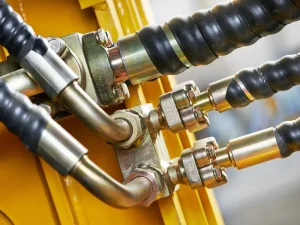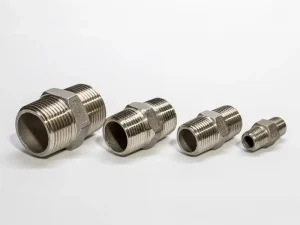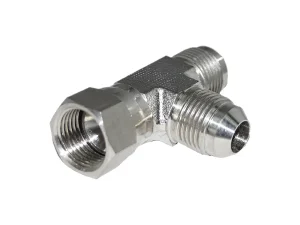Hydraulic systems are everywhere, from factory machines to airplanes. At the core of these systems are hydraulic hoses, which carry fluids safely. But these hoses can’t do the job alone. They need strong and reliable connectors to link them to pipes and valves. That’s where different hydraulic hose connection types come into play.
Among those, choosing the proper hydraulic connection is critical. Even the best hose will be useless if it is the wrong fitting and causes leakage and accidents. But, selecting a reliable fitting feels overwhelming, especially if you are a newbie to hydraulic systems. But you need not worry! This article will walk you through the most common types of hose connections.
Why Are Hydraulic Hose Connections Important?

Hydraulic hoses play a critical role in several industries. Their heavy-duty operation relies heavily on their robust connections. So, before we proceed to hose fitting types, let’s first look at why these connections are so important.
- Ensures Safety: Hydraulic hoses carry several hazardous fluids. Leakage can cause serious accidents, such as fire explosions. However, hose connectors ensure the leak-free transfer of those liquids and the safety of operators.
- Supports High Pressure: Hydraulic hoses often operate under high pressure. So, their proper connection helps them handle those high pressures. In this way, the connection ensures the system remains stable and effective.
- Enhances Longevity: An appropriate connection of the hose prevents wear and tear. It reduces the chances of repair and maintenance. This helps machinery last longer and perform better over time.
- Lower Maintenance Costs: As I said above, proper connection reduces frequent repair. When a system runs properly, it does not require maintenance or replacements. As a result, it lasts longer and saves money.
- Prevents Environmental Damage: Fluid leakage can contaminate the surroundings. A secure hose connection controls leakage, helps prevent spills, and protects the environment.
Types of Hydraulic Hose Connections
Several hydraulic hose connections are available. Each type is designed for specific uses and conditions. This section will explore some of the common types of hydraulic hose connections.
1- NPT (National Pipe Tapered)

NPT is a threaded connection used to connect pipes and hydraulic hoses. These connectors have spiral threads that match up with corresponding pipe threads. When you screw this fitting into the place, both threads press against each other.
As a result, a seal is created that completely blocks the fluid from wiping out. Due to this tapered design, these connectors do not need extra sealing material like tape. Hence, these fittings are commonly used in industrial machines and oil and gas industries.
2- BSP (British Standard Pipe)
BSP is a British standard for pipe fittings and thread used to connect hoses and pipes. These connectors are somehow similar to NPT. However, few changes take place due to its types. For example, BSP comes in two types:
- BSPP(British Standard Pipe Parallel): These threads are straight, which means they don’t taper. They require sealant or an O-ring for a leakage-proof connection; they do not create sealing on their own.
- BSPT(British Standard Pipe Tapered): These connectors are tapered, similar to NPT. This means they create sealant when threads press against each other.
BSP connections are known for their strength and reliability. These connectors efficiently work under high pressure and ensure leakage-proof fluid transfer. They are mainly used in the UK and other countries that use British standards.
3- JIC (Joint Industry Council)

JIC is a standard for hydraulic hose connection used in North America. JIC connectors have a 45-degree angled flare at the end of the hose or pipe. This angle allows the flare part of the hose fitting to press tightly against the flare part of the other fitting.
When these two ends are tightened with a nut, they compress and create a leak-proof seal. In this way, JIC connectors provide excellent leakage resistance. This makes them versatile for many industries, such as aerospace and automotive.
4- ORFS (O-Ring Face Seal)
It is a special type of hydraulic hose connection in which an O-ring forms a seal between two metal faces. Let me explain it in more simple terms. The O-ring in ORFS is present on the face of the fitting. Unlike other connectors, it is not inside the thread or tip of the fitting. So, when you tighten the fitting, the O-ring compresses against the flat surface.
This compression creates a leak-proof seal, ensuring no fluid escapes. What makes it special is the direct connection of the ring with the flat surface. This makes it ideal for achieving a good seal without additional sealing material. As the O-ring is itself a sealing element, it reduces leaks more efficiently than other types.
5- SAE Straight Thread (O-Ring Boss)
SAE stands for Society of Automotive Engineers. This organization sets standards for hose connections, so the SAE connection is also part of these standards. The SAE connection type of hydraulic fitting uses a straight thread and an O-ring to create a seal. HOW? Actually, straight threads are present outside the fittings.
They have the same diameter along the length. So, tightening the connector does not rely on the tread to create a seal. Instead, it uses an O ring located at the face of the fitting with a flat surface. On tightening, this O ring compresses against the mating surface and creates a tight seal. The O ring is the key to sealing and is ideal for high-pressure conditions.
6- Flange Fittings (SAE Code 61 and 62)
This type of hose connection uses flanges(a flat, circular surface) to create a secure seal between two ends. This fitting has a flat surface with bolt holes around the perimeter. When you place this connector, its flat face perfectly matches the corresponding flange joint. Once the flanges are aligned, bolts fasten them, creating a secure connection.
O rings are also present in these connectors. These rings further provide a leak-proof seal when flanges are bolted. Flanges fitting has two types: SAE code 61 and 62. These two types differ based on pressure handling. For example, SAE code 61 can handle low to medium pressure of about 3,000 psi. However, SAE code 62 can withstand high pressure of up to 6,000 psi.
7- Quick-Disconnect Couplings
Commonly known as a quick coupler, it is a special type of hose connection that is very easy to connect and disconnect. These connectors have two main parts: a plug (male part) and a socket(female part). You hear a click sound when you push the plug into the socket. This means they are connected and sealed tightly.
For disconnection, they have sleeves that you pull back and release the connection. Inside these fittings, there is a valve. This valve opens and allows fluid flow when you connect the plug and socket. However, when you disconnect the connector, this valve closes and blocks the fluid flow.
8- Camlock Couplings (Cam and Groove)
Camlock fittings are another type of hose connection that allows you to connect and disconnect the hose without using any tool. They use grooves and cam arms that resemble handles to provide a tight seal. Like quick couplers, camlock fittings have two main parts: a male adapter and a female coupler. This female coupler has two arms.
When you push the adapter inside the coupler, the arms come down and lock the two parts tightly. However, these arms lift for disconnection, and the two parts pull apart. Due to this easy connection and disconnection, camlock connections have become popular. They can handle several harsh fluids securely and save time.
9- Compression Fittings
As the name suggests, this fitting joins the hose with other parts by compressing a small ring around them. You can tighten this connector by hand, and there is no need for special tools or welding. Compression fitting mainly has three parts: fitting body, ferrule (ring), and nut. So, to connect the hose, you have to slide the nut and ring into the pipe that is present on it.
Then, push the pipe into the fitting body (main connector). Now screw the nut into the fitting body. When you start tightening, the nut moves the ferrule. As a result, ferrules squeeze and create a tight seal to prevent leakage. These connectors are easy to use and install. Therefore, they are commonly used in oil and gas transfer systems.
10- Metric Thread Fittings (DIN and ISO)
Metric thread fittings are designed according to standards like DIN and ISO. DIN is a German industrial standard; ISO is an International Standards Organization. These fittings use metric measurements for their thread instead of inches. Therefore, they are commonly used in European countries that follow a metric system.
Metric thread fitting has threads or spiral grooves or thread that match the thread on the hose. When you screw them tightly together, they lock tightly and seal the fluid from leaking. Some of these fittings also have additional O rings for extra safety. In this way, they can handle both high and low-pressure fluids.
How to Maintain Hydraulic Hose Connections
Maintaining the hydraulic hose is extremely important for the proper functioning of systems. If you don’t take care of them, a small problem can turn into a big one. As a result, the cost of repair and replacement increases, which can cause financial loss and waste time and money. Here are a few maintenance tips for your hydraulic connections to prevent those messes.
- Regular Inspections: Always check your hose connection regularly. Look for leaks, cracks, bulges, and wear and tear. If you notice any leaks, it’s a warning sign that something is wrong.
- Tighten Connections Properly: Hydraulic hose connections must be tightened but not over-tightened. If the connection is too weak, it will cause leakage; if it’s too tight, it can crack the fitting. So, always follow the torque recommendation given by the hose manufacturer.
- Clean Connections: Dust, dirt, and debris can cause massive problems inside the hydraulic system. So, clean both hoses and fittings before reconnecting them. Moreover, never leave the hose and fitting open. Cap them properly when disconnected.
- Replace Worn-Out Fittings: Hoses and connectors are not meant to last forever. Due to continuous use, they often wear out. So, when you notice worn-out parts, replace them immediately. Do not wait too long, as it can cause serious results.
- Avoid Twisting or Bending: Make sure the fitting is straight when installing a fitting. Twisting and bending at the fitting can put extra pressure. The result will be failure and earlier damage.
Frequently Asked Questions
Can I repair a hydraulic hose fitting myself?
In some cases, simple repairs can be done by yourself. For example, if the hydraulic fitting is loose and not damaged, you can tighten it with a simple tool. You can also replace worn-out O rings yourself. But, if hydraulic connections show significant wear and cracks, repairing them alone will not be possible.
Can different fitting types be mixed?
No, different fitting types should not be mixed. As you know, they have different thread standards and sealing methods. Mixing them will cause leakage and cracks in the hose.
What happens if a hydraulic fitting fails?
Hydraulic hoses primarily work under high-pressure fluids. Failure of the hose connection can lead to leakage of those hazardous fluids and cause safety issues. Fitting failure can also cause a drop in hydraulic pressure, affecting the machine’s performance.
Conclusion
Hydraulic hoses are potent tools for transferring several chemicals and liquids. However, they rely on the most minor details for their efficient work. One of those factors is the hose connection. Whether it is airplane parts or factory machines, the proper connection makes all the difference. A loose or wrong fitting leads to machinery failure and fluid leaks.
Therefore, I have explored some common types of hose connections in this article. All those types vary in design and are specific to different pressure ratings. Thus, choosing the right one for your needs is crucial. After that, maintenance of that particular hose connection is also essential for high hose performance.
